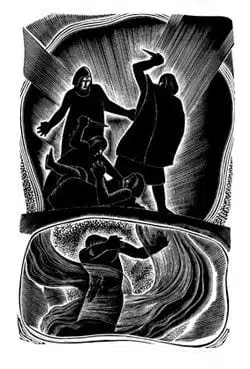
The other day, my girlfriend and I wandered into the delightful local comic store, Copacetic Comics, and I saw Southern Cross: A Novel of the South Seas displayed on one of the shelves. As I was having trouble finding words to review this (appropriately, enough) wordless novel, I asked the kindly owner for his thoughts on the book. You see, I had been wrestling the previous few days with Laurence Hyde’s woodcut piece about a fictional nuclear testing on a small island. I was torn between my instincts which told me the work was just average and my sense of literary historicity which demanded I respect the allegedly groundbreaking novel.
The owner replied that it was curious that Drawn and Quarterly chose to publish Southern Cross in a standalone edition, when it had a few months prior been published in George Walker’s Graphic Witness, a collection of four woodcut novels. Furthermore, Hyde was not even the most proficient at the form, eclipsed plainly by Lynd Ward and, arguably, the other artists featured in Graphic Witness.
It was at this juncture that I realized the source of my malaise regarding Hyde’s book. Clearly, this publication was the progeny of historical lip-service and the hot-button anxiety of the destructivity of modern warfare. Although, can I really blame Drawn and Quarterly for playing to the audience — what else can a publisher do?
However, to the publisher’s credit, the piece is an absolute paragon of layout and printing. The cover features a texturized, cloth-like surface that makes you want to pick up the book just for the tactile stimulation. The gorgeous and solitary red embossed woodcut on the front and the red spine feature an elegant simplicity and are true credits to the designer. However, the presentation of the 118 some woodcuts that comprise the story is the aesthetic coup d’état of the piece.
Printed on heavily weighted white pages, each frame is laterally centered and justified to the top third of each page, surrounded by thick, blank margins. This Spartan presentation is a boon to the efficacy of the panels, communicating the maddening claustrophobia and silent horror of the story. Isolated against their bare borders, the panels seem to scream out from the nothingness of universality; the empty edges channel the transcendentality of mythos.
If you are wondering why two paragraphs into the review I have barely touched upon the actual content of the novel, it is because I cannot imagine anyone buying the book solely for its story. This book of 118 pages of woodcut takes all of five minutes to read and the introduction and postscript, while informative, hardly warrant the purchase.
Simply, this book is intended, in every way, to be bought as a coffee table relic, the kind of purchase you set in conspicuous places in your house so that your guests will admire your cultured tastes. From the moment you touch the book, you can almost hear the voices of your dilettante friends saying, “Oh, how continental of you… (insert critique of American politics and warmongering here)… are you acquainted with the works of Chomsky…” The hypothetical monologue will end here as, have you any sense, you will stop listening at about this point in the conversation, annoyed at your friends’ prolixity but reassured in your cultural relevance.
Do I fault Hyde for any of this? Absolutely not. Produced in the early ’50s, Southern Cross predates even Eisner in claim to the ancestry of the modern graphic novel. The woodcut style (as opposed to the easier and more common method of wood engraving) is extremely labor intensive and, to Hyde’s credit, he uses the medium to excellent effect. The sharp lines and overwhelming geometry of the woodcut is a perfect expression of the fear and severity of modernized warfare.
The story is that of a family of indigenous island folk, asked to evacuate the island, which will serve as a testing ground by the US military. On the way, a drunken soldier tries to rape the mother and is killed. The family flees, the bomb goes off, and I won’t spoil the ending (although the introduction to the piece will). The story is powerful and many of the panels are gorgeous and evocative.
Southern Cross as a product, rather than as the woodcuts it contains, is a prime case of problematic publishing. Both the author and the publisher deserve to be praised for their achievements in art and design. However, the intended audience deserves to be censured. Truthfully, it is possible to own this novel without being rank-and-file, self-satisfied intelligentsia. It is just very hard to do so.
Graphic Witness cost only slightly more and gives you four times the content and a slew of additional commentary and history. However, a copy of Graphic Witness on display in your drawing room is tantamount to propping up a text book. Drawn and Quarterly’s little novel is a statement. Ultimately, it is up to you to choose the index or the artifact. However, either way you go, the decision alone begs the bigger question: why are our bookcases populated with gilded pages and blazoned spines rather than unbeseeming volumes of anthology and manuscript?
